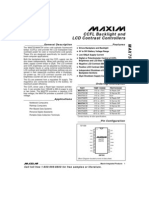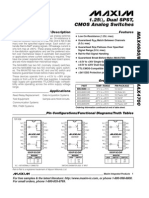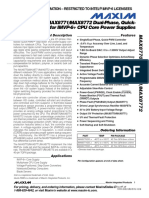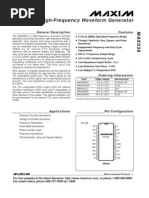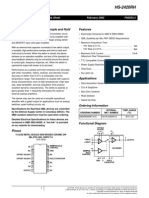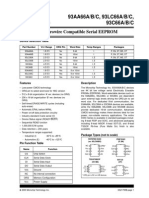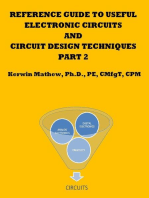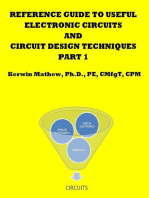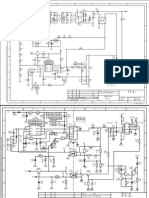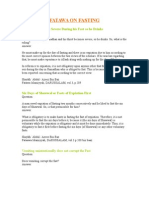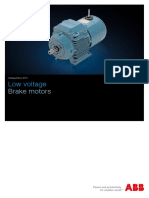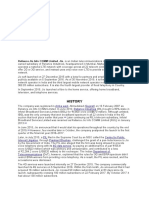Max 713
Max 713
Uploaded by
Alfredo Valencia RodriguezCopyright:
Available Formats
Max 713
Max 713
Uploaded by
Alfredo Valencia RodriguezOriginal Title
Copyright
Available Formats
Share this document
Did you find this document useful?
Is this content inappropriate?
Copyright:
Available Formats
Max 713
Max 713
Uploaded by
Alfredo Valencia RodriguezCopyright:
Available Formats
19-0100; Rev 3; 1/97
NUALS KIT MA N IO T T A A SHEE EVALU W DAT FOLLO
NiCd/NiMH Battery Fast-Charge Controllers
____________________________Features
o Fast Charge NiMH or NiCd Batteries o Voltage Slope, Temperature, and Timer Fast-Charge Cutoff o Charge 1 to 16 Series Cells o Supply Batterys Load while Charging (Linear Mode) o Fast Charge from C/4 to 4C Rate o C/16 Trickle-Charge Rate o Automatically Switch from Fast to Trickle Charge o Linear or Switch-Mode Power Control o 5A Max Drain on Battery when Not Charging o 5V Shunt Regulator Powers External Logic
_______________General Description
The MAX712/MAX713 fast charge Nickel Metal Hydride (NiMH) and Nickel Cadmium (NiCd) batteries from a DC source at least 1.5V higher than the maximum battery voltage. 1 to 16 series cells can be charged at rates up to 4C. A voltage-slope detecting analog-to-digital converter, timer, and temperature window comparator determine charge completion. The MAX712/MAX713 are powered by the DC source via an on-board +5V shunt regulator. They draw a maximum of 5 A from the battery when not charging. A low-side current-sense resistor allows the battery charge current to be regulated while still supplying power to the batterys load. The MAX712 terminates fast charge by detecting zero voltage slope, while the MAX713 uses a negative voltage-slope detection scheme. Both parts come in 16pin DIP and SO packages. An external power PNP transistor, blocking diode, three resistors, and three capacitors are the only required external components. For high-power charging requirements, the MAX712/ MAX713 can be configured as a switch-mode battery charger that minimizes power dissipation. Two evaluation kits are available: Order the MAX712EVKIT-DIP for quick evaluation of the linear charger, and the MAX713EVKITSO to evaluate the switch-mode charger.
MAX712/MAX713
______________Ordering Information
PART MAX712CPE MAX712CSE MAX712C/D MAX712EPE MAX712ESE MAX712MJE TEMP. RANGE 0C to +70C 0C to +70C 0C to +70C -40C to +85C -40C to +85C -55C to +125C PIN-PACKAGE 16 Plastic DIP 16 Narrow SO Dice* 16 Plastic DIP 16 Narrow SO 16 CERDIP**
________________________Applications
Battery-Powered Equipment Laptop, Notebook, and Palmtop Computers Handy-Terminals Cellular Phones Portable Consumer Products Portable Stereos Cordless Phones
Ordering Information continued at end of data sheet. *Contact factory for dice specifications. **Contact factory for availability and processing to MIL-STD-883.
__________Typical Operating Circuit
DC IN C4 0.01F Q1 2N6109 R2 150
R1
__________________Pin Configuration
TOP VIEW
VLIMIT 1 BATT+ 2 PGM0 3 PGM1 4 THI 5 TLO 6 TEMP 7 FASTCHG 8 16 REF 15 V+ 14 DRV
WALL CUBE C1 1F R3 68k
THI V+ VLIMIT REF
DRV
D1 1N4001
BATT+ C3 10F
MAX712 MAX713
TEMP
BATTERY
MAX712 MAX713
13 GND 12 BATT11 CC 10 PGM3 9 PGM2 10F R4 22k
LOAD CC BATT- TLO GND C2 0.01F
RSENSE
DIP/SO
SEE FIGURE 19 FOR SWITCH-MODE CHARGER CIRCUIT.
________________________________________________________________ Maxim Integrated Products
For free samples & the latest literature: http://www.maxim-ic.com, or phone 1-800-998-8800
NiCd/NiMH Battery Fast-Charge Controllers MAX712/MAX713
ABSOLUTE MAXIMUM RATINGS
V+ to BATT- .................................................................-0.3V, +7V BATT- to GND ........................................................................1V BATT+ to BATTPower Not Applied............................................................20V With Power Applied ................................The higher of 20V or 2V x (programmed cells) DRV to GND ..............................................................-0.3V, +20V FASTCHG to BATT- ...................................................-0.3V, +12V All Other Pins to GND......................................-0.3V, (V+ + 0.3V) V+ Current.........................................................................100mA DRV Current. .....................................................................100mA REF Current.........................................................................10mA Continuous Power Dissipation (TA = +70C) Plastic DIP (derate 10.53mW/C above +70C............842mW Narrow SO (derate 8.70mW/C above +70C .............696mW CERDIP (derate 10.00mW/C above +70C ................800mW Operating Temperature Ranges MAX71_C_E .......................................................0C to +70C MAX71_E_E .................................................... -40C to +85C MAX71_MJE ................................................. -55C to +125C Storage Temperature Range .............................-65C to +150C Lead Temperature (soldering, 10sec) .............................+300C
Stresses beyond those listed under Absolute Maximum Ratings may cause permanent damage to the device. These are stress ratings only, and functional operation of the device at these or any other conditions beyond those indicated in the operational sections of the specifications is not implied. Exposure to absolute maximum rating conditions for extended periods may affect device reliability.
ELECTRICAL CHARACTERISTICS
(IV+ = 10mA, TA = TMIN to TMAX, unless otherwise noted. Refer to Typical Operating Circuit. All measurements are with respect to BATT-, not GND.) PARAMETER V+ Voltage IV+ (Note 1) BATT+ Leakage BATT+ Resistance with Power On C1 Capacitance C2 Capacitance REF Voltage Undervoltage Lockout External VLIMIT Input Range THI, TLO, TEMP Input Range THI, TLO Offset Voltage (Note 2) THI, TLO, TEMP, VLIMIT Input Bias Current VLIMIT Accuracy Internal Cell Voltage Limit Fast-Charge VSENSE PGM3 = V+ Trickle-Charge VSENSE PGM3 = open PGM3 = REF PGM3 = BATTVoltage-Slope Sensitivity (Note 3) Timer Accuracy Battery-Voltage to Cell-Voltage Divider Accuracy DRV Sink Current 2 VDRV = 10V MAX713 MAX712 -15 -1.5 30 1.2V < VLIMIT < 2.5V, 5mA < IDRV < 20mA, PGM0 = PGM1 = V+ VLIMIT = V+ 0V < TEMP < 2V, TEMP voltage rising 0mA < IREF < 1mA Per cell V+ = 0V, BATT+ = 17V PGM0 = PGM1 = BATT-, BATT+ = 30V 30 0.5 5 1.96 0.35 1.25 0 -10 -1 -30 1.6 225 1.5 4.5 12.0 26.0 1.65 250 3.9 7.8 15.6 31.3 -2.5 0 15 1.5 2.04 0.50 2.50 2 10 1 30 1.7 275 7.0 12.0 20.0 38.0 mV/tA per cell % % mA mV CONDITIONS 5mA < IV+ < 20mA MIN 4.5 5 5 TYP MAX 5.5 UNITS V mA A k F nF V V V V mV A mV V mV
_______________________________________________________________________________________
NiCd/NiMH Battery Fast-Charge Controllers
ELECTRICAL CHARACTERISTICS (continued)
(IV+ = 10mA, TA = TMIN to TMAX, unless otherwise noted. Refer to Typical Operating Circuit. All measurements are with respect to BATT-, not GND.) PARAMETER FASTCHG Low Current FASTCHG High Current A/D Input Range (Note 4) CONDITIONS V FASTCHG = 0.4V V FASTCHG = 10V Battery voltage number of cells programmed 1.4 MIN 2 10 1.9 TYP MAX UNITS mA A V
MAX712/MAX713
Note 1: The MAX712/MAX713 are powered from the V+ pin. Since V+ shunt regulates to +5V, R1 must be small enough to allow at least 5mA of current into the V+ pin. Note 2: Offset voltage of THI and TLO comparators referred to TEMP. Note 3: tA is the A/D sampling interval (Table 3). Note 4: This specification can be violated when attempting to charge more or fewer cells than the number programmed. To ensure proper voltage-slope fast-charge termination, the (maximum battery voltage) (number of cells programmed) must fall within the A/D input range.
__________________________________________Typical Operating Characteristics
(TA = +25C, unless otherwise noted.)
CURRENT-SENSE AMPLIFIER FREQUENCY RESPONSE (with 15pF)
MAX712/13 LOG1
CURRENT-SENSE AMPLIFIER FREQUENCY RESPONSE (with 10nF)
C2 = 10nF FASTCHG = 0V 0 PHASE (DEGREES) GAIN (dB) 10 AV 0 -10 -80 -40
MAX712/13 LOG2
20 C2 = 15pF FASTCHG = 0V 10 GAIN (dB) AV 0
40
20
40
0 PHASE (DEGREES) 30 25 20 15 10 5 0 0 10 20 30 40 50 60 BATTERY TEMPERATURE(C) BATTERY THERMISTOR RESISTANCE (k) 35
-40
BATT-
-10
CC CURRENTSENSE AMP BATT+
-80
VIN
-
VOUT
-
GND
-20 1k 10k 100k FREQUENCY (Hz) 1M 10M
-120
-20 10 100 1k 10k FREQUENCY (Hz)
-120
CURRENT ERROR-AMPLIFIER TRANSCONDUCTANCE
MAX712/13 LOG3
SHUNT-REGULATOR VOLTAGE vs. CURRENT
5.6 5.4 DRV NOT SINKING CURRENT
MAX712/13 LOG4
ALPHA THERMISTOR PART No. 13A1002 STEINHART-HART INTERPOLATION
1.6 1.4 TEMP PIN VOLTAGE (V) 60 1.2 1.0 0.8 0.6 0.4 0.2
100 FASTCHG = 0V, V+ = 5V DRV PIN SINK CURRENT(mA)
5.8
10
V+ VOLTAGE (V)
5.2 5.0 4.8 4.6 4.4 4.2 DRV SINKING CURRENT
0.1 1.95
4.0 1.97 1.99 2.01 2.03 2.05 0 10 20 30 40 50 VOLTAGE ON CC PIN (V) CURRENT INTO V+ PIN (mA)
_______________________________________________________________________________________
NiCd/NiMH Battery Fast-Charge Controllers MAX712/MAX713
____________________________Typical Operating Characteristics (continued)
(TA = +25C, unless otherwise noted.) MAX713 NiCd BATTERY-CHARGING CHARACTERISTICS AT C RATE
MAX712/713
MAX713 NiMH BATTERY-CHARGING CHARACTERISTICS AT C RATE
MAX712/713
CELL TEMPERATURE (C)
1.50
V CUTOFF t
35
1.55
V CUTOFF t
35
1.45 T 1.40
30
1.50 T 1.45
30
25
25
30
60
90
30
60
90
CHARGE TIME (MINUTES)
CHARGE TIME (MINUTES)
MAX713 NiCd BATTERY-CHARGING CHARACTERISTICS AT C/2 RATE
MAX712/713
MAX713 NiMH BATTERY-CHARGING CHARACTERISTICS AT C/2 RATE
MAX712/713
1.50 CELL VOLTAGE (V)
35
CELL TEMPERATURE (C)
1.50 V 1.45 T 1.40
35
1.45
30
30
T 1.40
25
25
50
100
150
50
100
150
CHARGE TIME (MINUTES)
CHARGE TIME (MINUTES)
MAX713 CHARGING CHARACTERISTICS OF A FULLY CHARGED NiMH BATTERY
MAX712/713
MAX713 CHARGING CHARACTERISTICS OF A FULLY CHARGED NiMH BATTERY
MAX712/713
1.65 V 1.60 CELL VOLTAGE (V) 5-MINUTE REST BETWEEN CHARGES V CUTOFF t
1.65 V
CELL TEMPERATURE (C)
1.55
35
1.55 5-HOUR REST BETWEEN CHARGES 1.50 T 1.45
35
1.50
30
30
1.45
25
25
10
15
20
10
15
20
CHARGE TIME (MINUTES)
CHARGE TIME (MINUTES)
_______________________________________________________________________________________
CELL TEMPERATURE (C)
40
1.60 CELL VOLTAGE (V)
V CUTOFF t
40
CELL TEMPERATURE (C)
CELL VOLTAGE (V)
V CUTOFF t
1.55
V CUTOFF t
40
CELL TEMPERATURE (C)
1.55 CELL VOLTAGE (V)
40
1.60 CELL VOLTAGE (V)
40
NiCd/NiMH Battery Fast-Charge Controllers
______________________________________________________________Pin Description
PIN 1 2 NAME VLIMIT BATT+ FUNCTION Sets the maximum cell voltage. The battery terminal voltage (BATT+ - BATT-) will not exceed VLIMIT x (number of cells). Do not allow VLIMIT to exceed 2.5V. Tie VLIMIT to VREF for normal operation. Positive terminal of battery PGM0 and PGM1 set the number of series cells to be charged. The number of cells can be set from 1 to 16 by connecting PGM0 and PGM1 to any of V+, REF, or BATT-, or by leaving the pin open (Table 2). For cell counts greater than 11, see the Linear-Mode, High Series Cell Count section. Charging more or fewer cells than the number programmed may inhibit V fast-charge termination. Trip point for the over-temperature comparator. If the voltage-on TEMP rises above THI, fast charge ends. Trip point for the under-temperature comparator. If the MAX712/MAX713 power on with the voltage-on TEMP less than TLO, fast charge is inhibited and will not start until TEMP rises above TLO. Sense input for temperature-dependent voltage from thermistors. Open-drain, fast-charge status output. While the MAX712/MAX713 fast charge the battery, FASTCHG sinks current. When charge ends and trickle charge begins, FASTCHG stops sinking current. PGM2 and PGM3 set the maximum time allowed for fast charging. Timeouts from 33 minutes to 264 minutes can be set by connecting to any of V+, REF, or BATT-, or by leaving the pin open (Table 3). PGM3 also sets the fast-charge to trickle-charge current ratio (Table 5). Compensation input for constant current regulation loop Negative terminal of battery System ground. The resistor placed between BATT- and GND monitors the current into the battery. Current sink for driving the external PNP current source Shunt regulator. The voltage on V+ is regulated to +5V with respect to BATT-, and the shunt current powers the MAX712/MAX713. 2V reference output
MAX712/MAX713
3, 4
PGM0, PGM1
5 6 7 8
THI TLO TEMP FASTCHG PGM2, PGM3 CC BATTGND DRV V+ REF
9, 10 11 12 13 14 15 16
_______________________________________________________________________________________
NiCd/NiMH Battery Fast-Charge Controllers MAX712/MAX713
____________________Getting Started
The MAX712/MAX713 are simple to use. A complete linear-mode or switch-mode fast-charge circuit can be designed in a few easy steps. A linear-mode design uses the fewest components and supplies a load while charging, while a switch-mode design may be necessary if lower heat dissipation is desired. 1) Follow the battery manufacturers recommendations on maximum charge currents and charge-termination methods for the specific batteries in your application. Table 1 provides general guidelines. and PGM1 must be adjusted accordingly. Attempting to charge more or fewer cells than the number programmed can disable the voltage-slope fast-charge termination circuitry. The internal ADCs input voltage range is limited to between 1.4V and 1.9V (see the Electrical Characteristics), and is equal to the voltage across the battery divided by the number of cells programmed (using PGM0 and PGM1, as in Table 2). When the ADCs input voltage falls out of its specified range, the voltage-slope termination circuitry can be disabled. 4) Choose an external DC power source (e.g., wall cube). Its minimum output voltage (including ripple) must be greater than 6V and at least 1.5V higher (2V for switch mode) than the maximum battery voltage while charging. This specification is critical because normal fast-charge termination is ensured only if this requirement is maintained (see Powering the MAX712/MAX713 section for more details). 5) For linear-mode designs, calculate the worst-case power dissipation of the power PNP and diode (Q1 and D1 in the Typical Operating Circuit) in watts, using the following formula: PD PNP = (maximum wall-cube voltage under load - minimum battery voltage) x (charge current in amps) If the maximum power dissipation is not tolerable for your application, refer to the Detailed Description or use a switch-mode design (see Switch-Mode Operation in the Applications Information section, and see the MAX713 EV kit manual). 6) For both linear and switch-mode designs, limit current into V+ to between 5mA and 20mA. For a fixed or narrow-range input voltage, choose R1 in the Typical Operation Circuit using the following formula: R1 = (minimum wall-cube voltage - 5V) / 5mA For designs requiring a large input voltage variation, choose the current-limiting diode D4 in Figure 19. 7) Choose RSENSE using the following formula: RSENSE = 0.25V / (IFAST) 8) Consult Tables 2 and 3 to set pin-straps before applying power. For example, to fast charge at a rate of C/2, set the timeout to between 1.5x or 2x the charge period, three or four hours, respectively.
Table 1. Fast-Charge Termination Methods
Charge Rate > 2C NiMH Batteries V/t and temperature, MAX712 or MAX713 V/t and/or temperature, MAX712 or MAX713 V/t and/or temperature, MAX712 NiCd Batteries V/t and/or temperature, MAX713 V/t and/or temperature, MAX713 V/t and/or temperature, MAX713
2C to C/2
< C/2
2) Decide on a charge rate (Tables 3 and 5). The slowest fast-charge rate for the MAX712/MAX713 is C/4, because the maximum fast-charge timeout period is 264 minutes. A C/3 rate charges the battery in about three hours. The current in mA required to charge at this rate is calculated as follows: IFAST = (capacity of battery in mAh) (charge time in hours) Depending on the battery, charging efficiency can be as low as 80%, so a C/3 fast charge could take 3 hours and 45 minutes. This reflects the efficiency with which electrical energy is converted to chemical energy within the battery, and is not the same as the powerconversion efficiency of the MAX712/MAX713. 3) Decide on the number of cells to be charged (Table 2). If your battery stack exceeds 11 cells, see the LinearMode High Series Cell Count section. Whenever changing the number of cells to be charged, PGM0
_______________________________________________________________________________________
NiCd/NiMH Battery Fast-Charge Controllers MAX712/MAX713
Table 2. Programming the Number of Cells
Number of Cells 1 2 3 4 5 6 7 8 9 10 11 12 13 14 15 16 PGM1 Connection V+ Open REF BATTV+ Open REF BATTV+ Open REF BATTV+ Open REF BATTPGM0 Connection V+ V+ V+ V+ Open Open Open Open REF REF REF REF BATTBATTBATTBATT-
Table 3. Programming the Maximum Charge Time
Timeout (min) A/D Sampling Interval (sec) (tA) VoltageSlope Termination PGM3 Connection PGM2 Connection
22 22 33 33 45 45 66 66 90 90 132 132 180 180 264 264
21 21 21 21 42 42 42 42 84 84 84 84 168 168 168 168
Disabled Enabled Disabled Enabled Disabled Enabled Disabled Enabled Disabled Enabled Disabled Enabled Disabled Enabled Disabled Enabled
V+ V+ V+ V+ Open Open Open Open REF REF REF REF BATTBATTBATTBATT-
Open REF V+ BATTOpen REF V+ BATTOpen REF V+ BATTOpen REF V+ BATT-
V+ +5V SHUNT REGULATOR PGM2 PGM3 FASTCHG TIMED_OUT TIMER BATTFAST_CHARGE PGM2 PGM3 V DETECTION V_DETECT CONTROL LOGIC IN_REGULATION CURRENT AND VOLTAGE REGULATOR DRV CC BATTGND VLIMIT BATT+ PGMx 100k PGM0 CELL_VOLTAGE REF 100k BATTPOWER_ON_RESET N GND
V+
THI TEMP TLO
TEMPERATURE COMPARATORS
HOT COLD
UNDER_VOLTAGE
MAX712 MAX713
PGM1 BATTINTERNAL IMPEDANCE OF PGM0PGM3 PINS
0.4V BATT-
Figure 1. Block Diagram
_______________________________________________________________________________________ 7
NiCd/NiMH Battery Fast-Charge Controllers MAX712/MAX713
_______________Detailed Description
The MAX712/MAX713 fast charge NiMH or NiCd batteries by forcing a constant current into the battery. The MAX712/MAX713 are always in one of two states: fast charge or trickle charge. During fast charge, the current level is high; once full charge is detected, the current reduces to trickle charge. The device monitors three variables to determine when the battery reaches full charge: voltage slope, battery temperature, and charge time. Figure 1 shows the block diagram for the MAX712/ MAX713. The timer, voltage-slope detection, and temperature comparators are used to determine full charge state. The voltage and current regulator controls output voltage and current, and senses battery presence. Figure 2 shows a typical charging scenario with batteries already inserted before power is applied. At time 1, the MAX712/MAX713 draw negligible power from the battery. When power is applied to DC IN (time 2), the power-on reset circuit (see the POWER_ON_RESET signal in Figure 1) holds the MAX712/MAX713 in trickle charge. Once POWER_ON_RESET goes high, the device enters the fast-charge state (time 3) as long as the cell voltage is above the undervoltage lockout (UVLO) voltage (0.4V per cell). Fast charging cannot start until (battery voltage) / (number of cells) exceeds 0.4V. When the cell voltage slope becomes negative, fast charge is terminated and the MAX712/MAX713 revert to trickle-charge state (time 4). When power is removed (time 5), the device draws negligible current from the battery. Figure 3 shows a typical charging event using temperature full-charge detection. In the case shown, the battery pack is too cold for fast charging (for instance, brought in from a cold outside environment). During time 2, the MAX712/MAX713 remain in trickle-charge state. Once a safe temperature is reached (time 3), fast charge starts. When the battery temperature exceeds the limit set by THI, the MAX712/MAX713 revert to trickle charge (time 4).
1.4 1.3 0.4 0 A
VOLTAGE TEMPERATURE
CURRENT INTO CELL
mA A 3 TIME 4 5
1 2 1. NO POWER TO CHARGER 2. CELL VOLTAGE LESS THAN 0.4V 3. FAST CHARGE 4. TRICKLE CHARGE 5. CHARGER POWER REMOVED
Figure 2. Typical Charging Using Voltage Slope
CELL TEMPERATURE
CELL VOLTAGE (V)
1.5
CURRENT INTO CELL CELL TEMPERATURE
VREF = VLIMIT THI CELL VOLTAGE (V) CURRENT INTO CELL 1.5 1.4 1.3
TLO A
A mA A 2 TIME 3 4
mA A 3 TIME 4
1 2 1. NO POWER TO CHARGER 2. CELL TEMPERATURE TOO LOW 3. FAST CHARGE 4. TRICKLE CHARGE
1 1. BATTERY NOT INSERTED 2. FAST CHARGE 3. TRICKLE CHARGE 4. BATTERY REMOVED
Figure 3. Typical Charging Using Temperature
8
Figure 4. Typical Charging with Battery Insertion
_______________________________________________________________________________________
NiCd/NiMH Battery Fast-Charge Controllers
The MAX712/MAX713 can be configured so that voltage slope and/or battery temperature detects full charge. Figure 4 shows a charging event in which a battery is inserted into an already powered-up MAX712/MAX713. During time 1, the chargers output voltage is regulated at the number of cells times VLIMIT. Upon insertion of the battery (time 2), the MAX712/MAX713 detect current flow into the battery and switch to fast-charge state. Once full charge is detected, the device reverts to trickle charge (time 3). If the battery is removed (time 4), the MAX712/MAX713 remain in trickle charge and the output voltage is once again regulated as in time 1. the voltage on the battery pack is higher during a fastcharge cycle than while in trickle charge or while supplying a load. The voltage across some battery packs may approach 1.9V/cell.
MAX712/MAX713
Q1 DC IN R2 R1 2N3904
D1
Powering the MAX712/MAX713
AC-to-DC wall-cube adapters typically consist of a transformer, a full-wave bridge rectifier, and a capacitor. Figures 1012 show the characteristics of three consumer product wall cubes. All three exhibit substantial 120Hz output voltage ripple. When choosing an adapter for use with the MAX712/MAX713, make sure the lowest wall-cube voltage level during fast charge and full load is at least 1.5V higher (2V for switch mode) than the maximum battery voltage while being fast charged. Typically,
V+
DRV
MAX712 MAX713
Figure 5. DRV Pin Cascode Connection (for high DC IN voltage or to reduce MAX712/MAX713 power dissipation in linear mode)
Table 4. MAX712/MAX713 Charge-State Transition Table POWER_ON_RESET UNDER_VOLTAGE IN_REGULATION COLD HOT
0 1 1 1 1 1 1 1 1 1 1 1 x 1 x x x 0 0 0 0 0 0 x x 0 x x x 1 x x 0 0 0 0 0 0 x x 0 x x x x 0 x 1 1 1 1 1 0 x x x x x x x x 0 1 1 1 1 1 1 x 0 x x Set trickle No change No change No change
Result*
No change*** Set fast No change No change Set fast Set fast No change*** Set fast** Trickle to fast transition inhibited Trickle to fast transition inhibited Set trickle Set trickle Set trickle
Only two states exist: fast charge and trickle charge. * Regardless of the status of the other logic lines, a timeout or a voltage-slope detection will set trickle charge. ** If the battery is cold at power-up, the first rising edge on COLD will trigger fast charge; however, a second rising edge will have no effect. *** Batteries that are too hot when inserted (or when circuit is powered up) will not enter fast charge until they cool and power is recycled. _______________________________________________________________________________________ 9
NiCd/NiMH Battery Fast-Charge Controllers MAX712/MAX713
DC IN V+
regulator sinks current to regulate V+ to 5V, and fast charge commences. The MAX712/MAX713 fast charge until one of the three fast-charge terminating conditions is triggered. If DC IN exceeds 20V, add a cascode connection in series with the DRV pin as shown in Figure 5 to prevent exceeding DRVs absolute maximum ratings. Furthermore, if Figure 19s DC IN exceeds 15V, a transistor level-shifter is needed to provide the proper voltage swing to the MOSFET gate. See the MAX713 EV kit manual for details. Select the current-limiting component (R1 or D4) to pass at least 5mA at the minimum DC IN voltage (see step 6 in the Getting Started section). The maximum current into V+ determines power dissipation in the MAX712/MAX713. maximum current into V+ = (maximum DC IN voltage - 5V) / R1
CC C2
REF DRV VLIMIT
D1 GND
CELL_VOLTAGE
CURRENT-SENSE AMPLIFIER PGM3 FAST_CHARGE Av X V+ OPEN REF BATT1 0 0 0 0 8 512 256 128 64
BATT-
power dissipation due to shunt regulator = 5V x (maximum current into V+) Sink current into the DRV pin also causes power dissipation. Do not allow the total power dissipation to exceed the specifications shown in the Absolute Maximum Ratings.
RSENSE
BATTIN_REGULATION 1.25V BATT-
BATT-
GND
Fast Charge
The MAX712/MAX713 enter the fast-charge state under one of the following conditions: 1) Upon application of power (batteries already installed), with battery current detection (i.e., GND voltage is less than BATT- voltage), and TEMP higher than TLO and less than THI and cell voltage higher than the UVLO voltage. 2) Upon insertion of a battery, with TEMP higher than TLO and lower than THI and cell voltage higher than the UVLO voltage. RSENSE sets the fast-charge current into the battery. In fast charge, the voltage difference between the BATTand GND pins is regulated to 250mV. DRV current increases its sink current if this voltage difference falls below 250mV, and decreases its sink current if the voltage difference exceeds 250mV. fast-charge current (IFAST) = 0.25V / RSENSE
Figure 6. Current and Voltage Regulator (linear mode)
The 1.5V of overhead is needed to allow for worst-case voltage drops across the pass transistor (Q1 of Typical Operating Circuit ), the diode (D1), and the sense resistor (RSENSE). This minimum input voltage requirement is critical, because violating it can inhibit proper termination of the fast-charge cycle. A safe rule of thumb is to choose a source that has a minimum input voltage = 1.5V + (1.9V x the maximum number of cells to be charged). When the input voltage at DC IN drops below the 1.5V + (1.9V x number of cells), the part oscillates between fast charge and trickle charge and might never completely terminate fast-charge. The MAX712/MAX713 are inactive without the wall cube attached, drawing 5 A (max) from the battery. Diode D1 prevents current conduction into the DRV pin. When the wall cube is connected, it charges C1 through R1 (see Typical Operating Circuit) or the current-limiting diode (Figure 19). Once C1 charges to 5V, the internal shunt
10
Trickle Charge
Selecting a fast-charge current (IFAST) of C/2, C, 2C, or 4C ensures a C/16 trickle-charge current. Other fastcharge rates can be used, but the trickle-charge current will not be exactly C/16.
______________________________________________________________________________________
NiCd/NiMH Battery Fast-Charge Controllers MAX712/MAX713
Table 5. Trickle-Charge Current Determination from PGM3
PGM3 V+ OPEN REF BATTFast-Charge Rate 4C 2C C C/2 Trickle-Charge Current (ITRICKLE) IFAST/64 IFAST/32 IFAST/16 IFAST/8
Q1 DC IN V+ DRV 10k Q2 10k D1
R7 BATTERY
MAX712 MAX713 FASTCHG
The MAX712/MAX713 internally set the trickle-charge current by increasing the current amplifier gain (Figure 6), which adjusts the voltage across R SENSE (see Trickle-Charge VSENSE in the Electrical Characteristics table).
RSENSE GND
Figure 7. Reduction of Trickle Current for NiMH Batteries (linear mode)
Nonstandard Trickle-Charge Current Example
Configuration: Typical Operating Circuit 2 x Panasonic P-50AA 500mAh AA NiCd batteries C/3 fast-charge rate 264-minute timeout Negative voltage-slope cutoff enabled Minimum DC IN voltage of 6V Settings: Use MAX713 PGM0 = V+, PGM1 = open, PGM2 = BATT-, PGM3 = BATT-, RSENSE = 1.5 (fast-charge current, IFAST = 167mA), R1 = (6V - 5V) / 5mA = 200 Since PGM3 = BATT-, the voltage on RSENSE is regulated to 31.3mV during trickle charge, and the current is 20.7mA. Thus the trickle current is actually C/25, not C/16.
Regulation Loop
The regulation loop controls the output voltage between the BATT+ and BATT- terminals and the current through the battery via the voltage between BATT- and GND. The sink current from DRV is reduced when the output voltage exceeds the number of cells times VLIMIT, or when the battery current exceeds the programmed charging current. For a linear-mode circuit, this loop provides the following functions: 1) When the charger is powered, the battery can be removed without interrupting power to the load. 2) If the load is connected as shown in the Typical Operating Circuit, the battery current is regulated regardless of the load current (provided the input power source can supply both).
Further Reduction of Trickle-Charge Current for NiMH Batteries
The trickle-charge current can be reduced to less than C/16 using the circuit in Figure 7. In trickle charge, some of the current will be shunted around the battery, since Q2 is turned on. Select the value of R7 as follows: where R7 = (VBATT + 0.4V) / (lTRlCKLE - IBATT) V BATT = battery voltage when charged ITRlCKLE = MAX712/MAX713 trickle-charge current setting IBATT = desired battery trickle-charge current
Voltage Loop
The voltage loop sets the maximum output voltage between BATT+ and BATT-. If VLIMIT is set to less than 2.5V, then: Maximum BATT+ voltage (referred to BATT-) = VLIMIT x (number of cells as determined by PGM0, PGM1) VLIMIT should be set between 1.9V and 2.5V. If VLIMIT is set below the maximum cell voltage, proper termination of the fast-charge cycle might not occur. Cell voltage can approach 1.9V/cell, under fast charge, in some battery packs. Tie VLIMIT to VREF for normal operation . With the battery removed, the MAX712/MAX713 do not provide constant current; they regulate BATT+ to the maximum voltage as determined above.
11
______________________________________________________________________________________
NiCd/NiMH Battery Fast-Charge Controllers MAX712/MAX713
The voltage loop is stabilized by the output filter capacitor. A large filter capacitor is required only if the load is going to be supplied by the MAX712/MAX713 in the absence of a battery. In this case, set COUT as: COUT (in farads) = (50 x ILOAD) / (VOUT x BWVRL) where BWVRL = loop bandwidth in Hz (10,000 recommended) COUT > 10F ILOAD = external load current in amps VOUT = programmed output voltage (VLIMIT x number of cells) terminated. Note that each cycle has two tA intervals and two voltage measurements. The MAX712 terminates fast charge when a comparison shows that the battery voltage is unchanging. The MAX713 terminates when a conversion shows the battery voltage has fallen by at least 2.5mV per cell. This is the only difference between the MAX712 and MAX713.
Temperature Charge Cutoff
Figure 9a shows how the MAX712/MAX713 detect overand under-temperature battery conditions using negative temperature coefficient thermistors. Use the same model thermistor for T1 and T2 so that both have the same nominal resistance. The voltage at TEMP is 1V (referred to BATT-) when the battery is at ambient temperature. The threshold chosen for THI sets the point at which fast charging terminates. As soon as the voltage-on TEMP rises above THI, fast charge ends, and does not restart after TEMP falls below THI. The threshold chosen for TLO determines the temperature below which fast charging will be inhibited. If TLO > TEMP when the MAX712/MAX713 start up, fast charge will not start until TLO goes below TEMP. The cold temperature charge inhibition can be disabled by removing R5, T3, and the 0.022 F capacitor; and by tying TLO to BATT-. To disable the entire temperature comparator chargecutoff mechanism, remove T1, T2, T3, R3, R4, and R5, and their associated capacitors, and connect THI to V+ and TLO to BATT-. Also, place a 68kQ resistor from REF to TEMP, and a 22k resistor from BATT- to TEMP. Some battery packs come with a temperature-detecting thermistor connected to the battery packs negative
Current Loop
Figure 6 shows the current-regulation loop for a linearmode circuit. To ensure loop stability, make sure that the bandwidth of the current regulation loop (BWCRL) is lower than the pole frequency of transistor Q1 (fB). Set BWCRL by selecting C2. BWCRL in Hz = gm / C2, C2 in farads, gm = 0.0018 Siemens The pole frequency of the PNP pass transistor, Q1, can be determined by assuming a single-pole current gain response. Both fT and Bo should be specified on the data sheet for the particular transistor used for Q1. fB in Hz = fT / Bo, fT in Hz, Bo = DC current gain Condition for Stability of Current-Regulation Loop: BWCRL < fB The MAX712/MAX713 dissipate power due to the current-voltage product at DRV. Do not allow the power dissipation to exceed the specifications shown in the Absolute Maximum Ratings. DRV power dissipation can be reduced by using the cascode connection shown in Figure 5 or by using a switch-mode circuit. Power dissipation due to DRV sink current = (current into DRV) x (voltage on DRV)
The MAX712/MAX713s internal analog-to-digital converter has 2.5mV of resolution. It determines if the battery voltage is rising, falling, or unchanging by comparing the batterys voltage at two different times. After power-up, a time interval of tA ranging from 21sec to 168sec passes (see Table 3 and Figure 8), then a battery voltage measurement is taken. It takes 5ms to perform a measurement. After the first measurement is complete, another t A interval passes, and then a second measurement is taken. The two measurements are compared, and a decision whether to terminate charge is made. If charge is not terminated, another full two-measurement cycle is repeated until charge is
12
COUNTS
Voltage-Slope Cutoff
VOLTAGE RISES
NEGATIVE ZERO VOLTAGE VOLTAGE SLOPE SLOPE CUTOFF FOR MAX712 CUTOFF FOR MAX712 OR MAX713
ZERO RESIDUAL NEGATIVE RESIDUAL
0
5ms 5ms
POSITIVE RESIDUAL
t
5ms 5ms 5ms 5ms
tA INTERVAL
tA INTERVAL
tA INTERVAL
tA INTERVAL
tA INTERVAL
tA INTERVAL
NOTE: SLOPE PROPORTIONAL TO VBATT
Figure 8. Voltage Slope Detection
______________________________________________________________________________________
NiCd/NiMH Battery Fast-Charge Controllers
IN THERMAL CONTACT WITH BATTERY R3 THI HOT R4 +2.0V COLD TLO TEMP 0.022F R5 T2 AMBIENT TEMPERATURE T1
REF
terminal. In this case, use the configuration shown in Figure 9b. Thermistors T2 and T3 can be replaced by standard resistors if absolute temperature charge cutoff is acceptable. All resistance values in Figures 9a and 9b should be chosen in the 10k to 500k range.
MAX712/MAX713
__________Applications Information
Switch-Mode Operation
For applications where the power dissipation in the pass transistor cannot be tolerated (ie., where heat sinking is not feasible or is too costly), a switch-mode charger is recommended. Switch-mode operation can be implemented simply by using the circuit of Figure 19. The circuit of Figure 19 uses the error amplifier at the CC pin as a comparator with the 33pF capacitor adding hysteresis. Figure 19 is shown configured to charge two cells at 1A. Lower charge currents and a different number of cells can be accommodated simply by changing R SENSE and PGM0PGM3 connections (Tables 2 and 3). The input power-supply voltage range is 8V to 15V and must be at least 2V greater than the peak battery voltage, under fast charge. As shown in Figure 19, the source should be capable of greater than 1.3A of output current. The source requirements are critical because if violated, proper termination of the fastcharge cycle might not occur. For input voltages greater than 15V, see the MAX713SWEVKIT data sheet.
MAX712 MAX713
BATTAMBIENT TEMPERATURE
T3
0.022F
1F
NOTE: FOR ABSOLUTE TEMPERATURE CHARGE CUTOFF, T2 AND T3 CAN BE REPLACED BY STANDARD RESISTORS.
Figure 9a. Temperature Comparators
REF
AMBIENT TEMPERATURE
T2 THI R5 +2.0V COLD TLO 0.022F 0.022F R4 T3 R3
10 OUTPUT VOLTAGE (V)
MAX712/713
HOT
11
TEMP 1F
HIGH PEAK 9
120Hz RIPPLE
MAX712 MAX713
T1 BATTIN THERMAL CONTACT WITH BATTERY
LOW PEAK
AMBIENT TEMPERATURE
6 0 200 400 600 800 1000 LOAD CURRENT (mA)
NOTE: FOR ABSOLUTE TEMPERATURE CHARGE CUTOFF, T2 AND T3 CAN BE REPLACED BY STANDARD RESISTORS.
Figure 9b. Alternative Temperature Comparator Configuration
Figure 10. Sony Radio AC Adapter AC-190 Load Characteristic, 9VDC 800mA
______________________________________________________________________________________
13
NiCd/NiMH Battery Fast-Charge Controllers
The voltage-slope, fast-charge termination circuitry might become disabled if attempting to charge a different number of cells than the number programmed. The switching frequency (nominally 30kHz) can be decreased by increasing the value of the capacitor connected between CC and BATT-. Make sure that the two capacitors connected to the CC node are placed as close as possible to the CC pin on the MAX712/MAX713 and that their leads are of minimum length. The CC node is a high-impedance point, so do not route logic lines near the CC pin. The circuit of Figure 19 cannot service a load while charging. Order the MAX713SWEVKIT-SO for quick evaluation of the MAX712/MAX713 in switch-mode operation. For more information on switch-mode operation and ordering information for external components, order the MAX713EVKIT data sheet.
MAX712/713
MAX712/MAX713
Battery-Charging Examples
Figures 13 and 14 show the results of charging 3 AA, 1000mAh, NiMH batteries from Gold Peak (part no. GP1000AAH, GP Batteries (619) 438-2202) at a 1A rate using the MAX712 and MAX713, respectively. The Typical Operating Circuit is used with Figure 9as thermistor configuration . DC IN = Sony AC-190 +9VDC at 800mA AC-DC adapter PGM0 = V+, PGM1 = REF, PGM2 = REF, PGM3 = REF R1 = 200 , R2 = 150 , RSENSE = 0.25 C1 = 1 F, C2 = 0.01 F, C3 = 10 F, VLIMIT = REF R3 = 10k , R4 = 15k T1, T2 = part #13A1002 (Alpha Thermistor: (800) 235-5445) R5 omitted, T3 omitted, TLO = BATT-
10 OUTPUT VOLTAGE (V) HIGH PEAK 9 8 7 LOW PEAK 6 5 0 400 200 600 LOAD CURRENT (mA) 800 1000 120Hz RIPPLE OUTPUT VOLTAGE (V)
16
14 HIGH PEAK 12 LOW PEAK 120Hz RIPPLE 0 400 200 600 LOAD CURRENT (mA) 800
10
Figure 11. Sony CD Player AC Adapter AC-96N Load Characteristic, 9VDC 600mA
Figure 12. Panasonic Modem AC Adapter KX-A11 Load Characteristic, 12VDC 500mA
MAX712/713 MAX712/713
11
18
BATTERY TEMPERATURE (C)
4.8 4.7 4.6 4.5 4.4 4.3 4.2 0 60 30 TIME (MINUTES) 90 T V
36 34 32 30 28 26 24
4.8 4.7 4.6 4.5 T 4.4 4.3 4.2 0 60 30 TIME (MINUTES) 90 V
36 34 32 30 28 26 24
Figure 13. 3 NiMH Cells Charged with MAX712
14
Figure 14. NiMH Cells Charged with MAX713
______________________________________________________________________________________
BATTERY TEMPERATURE (C)
4.9 BATTERY VOLTAGE (V)
V CUTOFF t
MAX712/713
5.0
40 38
5.0 4.9 BATTERY VOLTAGE (V)
V CUTOFF t
40 38
NiCd/NiMH Battery Fast-Charge Controllers
Linear-Mode, High Series Cell Count
The absolute maximum voltage rating for the BATT+ pin is higher when the MAX712/MAX713 are powered on. If more than 11 cells are used in the battery, the BATT+ input voltage must be limited by external circuitry when DC IN is not applied (Figure 15). significant only if R SENSE is much greater than the battery stacks internal resistance. The circuit in Figure 16 can be used to shunt the sense resistor whenever power is removed from the charger.
MAX712/MAX713
Status Outputs
Figure 17 shows a circuit that can be used to indicate charger status with logic levels. Figure 18 shows a circuit that can be used to drive LEDs for power and charger status.
Efficiency During Discharge
The current-sense resistor, RSENSE, causes a small efficiency loss during battery use. The efficiency loss is
Q1 DC IN R2 150
D1 TO BATTERY POSITIVE TERMINAL 33k Q2
V+
OV = NO POWER 5V = POWER
500
MAX712 MAX712 MAX713 MAX713
FASTCHG
VCC 10k OV = FAST VCC = TRICKLE OR NO POWER
DRV
MAX712 MAX713
BATT+
Figure 15. Cascoding to Accommodate High Cell Counts for Linear-Mode Circuits
Figure 17. Logic-Level Status Outputs
DC IN D1 R1
>4 CELLS
CHARGE POWER V+
MAX712 MAX713
100k V+
100k * RSENSE * LOW RON LOGIC LEVEL N-CHANNEL POWER MOSFET
470MIN
MAX712 MAX713
FAST CHARGE FASTCHG
GND
Figure 16. Shunting RSENSE for Efficiency Improvement
Figure 18. LED Connection for Status Outputs
15
______________________________________________________________________________________
NiCd/NiMH Battery Fast-Charge Controllers MAX712/MAX713
M1 IRFR9024 C5 10F 50V D4 CCLHM080 (8mA CURRENTLIMITING DIODE) 1 3 C6 10F 50V R2 5.1k 1 L1 D03340 220H 3 Q1 CMPTA06 2 2 1 Q2 2N2907 D1 MBRS340T3
DC IN 8V TO 15V
D2 MBRS340T3
3 Q4 CMPTA06 2
14 5 15 3 4 9 10 REF R6 68k R7 22k C1 1F 10V 16 1 7 THI V+ PGM0 MAX713 DRV
11 CC C2 220pF BATT+ 2 12 6 13 R3 0.25 2 x 1000mA-Hr NiCd CELLS BATT + C3 10F 50V BATT
PGM1 PGM2 PGM3 REF VLIMIT TEMP FASTCHG 8 TLD GND BATT-
C4 0.1F
R5 470
Figure 19. Simplest Switch-Mode Charger
16
______________________________________________________________________________________
NiCd/NiMH Battery Fast-Charge Controllers
_Ordering Information (continued)
PART MAX713CPE MAX713CSE MAX713C/D MAX713EPE MAX713ESE MAX713MJE TEMP. RANGE 0C to +70C 0C to +70C 0C to +70C -40C to +85C -40C to +85C -55C to +125C PIN-PACKAGE 16 Plastic DIP 16 Narrow SO Dice* 16 Plastic DIP 16 Narrow SO 16 CERDIP**
PGM0 PGM1
___________________Chip Topography
BATT+ VLIMIT REF V+
MAX712/MAX713
DRV
*Contact factory for dice specifications. **Contact factory for availability and processing to MIL-STD-883.
GND 0.126 (3.200mm) BATTTHI
CC TLO PGM3
TEMP
FASTCHG 0.80" (2.032mm)
PGM2
TRANSISTOR COUNT: 2193 SUBSTRATE CONNECTED TO V+
______________________________________________________________________________________
17
NiCd/NiMH Battery Fast-Charge Controllers MAX712/MAX713
NOTES
18
______________________________________________________________________________________
This datasheet has been downloaded from: www.DatasheetCatalog.com Datasheets for electronic components.
You might also like
- Anyone Can Go To Heaven, Just Be Good - The Path To Heaven and Beyond To NibbanaNo ratings yetAnyone Can Go To Heaven, Just Be Good - The Path To Heaven and Beyond To Nibbana88 pages
- 5V/3.3V/3V 5A Step-Down, PWM, Switch-Mode DC-DC Regulators: MAX787 Temp. Range Pin-PackageNo ratings yet5V/3.3V/3V 5A Step-Down, PWM, Switch-Mode DC-DC Regulators: MAX787 Temp. Range Pin-Package4 pages
- Miniature Single-Cell, Fully Integrated Li-Ion, Li-Polymer Charge Management ControllersNo ratings yetMiniature Single-Cell, Fully Integrated Li-Ion, Li-Polymer Charge Management Controllers24 pages
- Ultra-Small, Low-Cost, 85Mhz Op Amps With Rail-To-Rail Outputs and Disable100% (1)Ultra-Small, Low-Cost, 85Mhz Op Amps With Rail-To-Rail Outputs and Disable20 pages
- 1.25, Dual SPST, CMOS Analog Switches: General Description FeaturesNo ratings yet1.25, Dual SPST, CMOS Analog Switches: General Description Features12 pages
- Miniature, Low-Voltage, Precision Step-Down Controller: General Description - FeaturesNo ratings yetMiniature, Low-Voltage, Precision Step-Down Controller: General Description - Features20 pages
- 8-/4-/2-Channel, 12-Bit, Simultaneous-Sampling Adcs With 10V, 5V, and 0 To +5V Analog Input RangesNo ratings yet8-/4-/2-Channel, 12-Bit, Simultaneous-Sampling Adcs With 10V, 5V, and 0 To +5V Analog Input Ranges37 pages
- ISL6255, ISL6255A: Highly Integrated Battery Charger With Automatic Power Source Selector For Notebook Computers FeaturesNo ratings yetISL6255, ISL6255A: Highly Integrated Battery Charger With Automatic Power Source Selector For Notebook Computers Features22 pages
- +12V, 30ma Flash Memory Programming Supply: Evaluation Kit Manual Follows Data SheetNo ratings yet+12V, 30ma Flash Memory Programming Supply: Evaluation Kit Manual Follows Data Sheet6 pages
- CMOS Static RAM 256K (32K X 8-Bit) IDT71256S IDT71256L: Features DescriptionNo ratings yetCMOS Static RAM 256K (32K X 8-Bit) IDT71256S IDT71256L: Features Description10 pages
- NTE955MC Integrated Circuit CMOS Timing Circuit: DescriptionNo ratings yetNTE955MC Integrated Circuit CMOS Timing Circuit: Description7 pages
- Quick-PWM Master Controllers For Voltage-Positioned CPU Core Power Supplies (IMVP-IV)No ratings yetQuick-PWM Master Controllers For Voltage-Positioned CPU Core Power Supplies (IMVP-IV)43 pages
- Remote/Local Temperature Sensor With Smbus Serial InterfaceNo ratings yetRemote/Local Temperature Sensor With Smbus Serial Interface20 pages
- MAX8770/MAX8771/MAX8772 Dual-Phase, Quick-PWM Controller For IMVP-6+ CPU Core Power SuppliesNo ratings yetMAX8770/MAX8771/MAX8772 Dual-Phase, Quick-PWM Controller For IMVP-6+ CPU Core Power Supplies47 pages
- 5th-Order, Lowpass, Switched-Capacitor Filters: General Description FeaturesNo ratings yet5th-Order, Lowpass, Switched-Capacitor Filters: General Description Features12 pages
- Features Description: Lt3763 60V High Current Step-Down Led Driver ControllerNo ratings yetFeatures Description: Lt3763 60V High Current Step-Down Led Driver Controller30 pages
- 8th-Order, Lowpass, Bessel, Switched-Capacitor Filters: General Description FeaturesNo ratings yet8th-Order, Lowpass, Bessel, Switched-Capacitor Filters: General Description Features12 pages
- 5V/12V/15V or Adjustable, High-Efficiency, Low I, Step-Up DC-DC ControllersNo ratings yet5V/12V/15V or Adjustable, High-Efficiency, Low I, Step-Up DC-DC Controllers20 pages
- 1.2Mhz Low-Cost, High-Performance Chargers: General Description FeaturesNo ratings yet1.2Mhz Low-Cost, High-Performance Chargers: General Description Features24 pages
- Power-Management Ics For Single-Cell, Li+ Battery-Operated DevicesNo ratings yetPower-Management Ics For Single-Cell, Li+ Battery-Operated Devices34 pages
- LM555 Timer: General Description FeaturesNo ratings yetLM555 Timer: General Description Features12 pages
- Low Cost Multi-Chemistry Battery Charger Controller: ISL6251, ISL6251ANo ratings yetLow Cost Multi-Chemistry Battery Charger Controller: ISL6251, ISL6251A20 pages
- Dual-Phase, Quick-PWM Controllers For IMVP-IV CPU Core Power SuppliesNo ratings yetDual-Phase, Quick-PWM Controllers For IMVP-IV CPU Core Power Supplies45 pages
- Single/Dual, Ultra-Fast, Low-Power Precision TTL ComparatorsNo ratings yetSingle/Dual, Ultra-Fast, Low-Power Precision TTL Comparators11 pages
- LM555 Timer: Literature Number: SNAS548BNo ratings yetLM555 Timer: Literature Number: SNAS548B14 pages
- Dual, Ultra-Low-Power, 10-Bit, Voltage-Output Dacs: General Description FeaturesNo ratings yetDual, Ultra-Low-Power, 10-Bit, Voltage-Output Dacs: General Description Features23 pages
- Reference Guide To Useful Electronic Circuits And Circuit Design Techniques - Part 2From EverandReference Guide To Useful Electronic Circuits And Circuit Design Techniques - Part 2No ratings yet
- Reference Guide To Useful Electronic Circuits And Circuit Design Techniques - Part 1From EverandReference Guide To Useful Electronic Circuits And Circuit Design Techniques - Part 12.5/5 (3)
- Influence of System Parameters Using Fuse Protection of Regenerative DC DrivesFrom EverandInfluence of System Parameters Using Fuse Protection of Regenerative DC DrivesNo ratings yet
- Power Systems-On-Chip: Practical Aspects of DesignFrom EverandPower Systems-On-Chip: Practical Aspects of DesignBruno AllardNo ratings yet
- Off-Line Quasi-Resonant Switching Regulators: STR-X6769No ratings yetOff-Line Quasi-Resonant Switching Regulators: STR-X67699 pages
- Audio Frequency Power Amplifier Applications: Absolute Maximum RatingsNo ratings yetAudio Frequency Power Amplifier Applications: Absolute Maximum Ratings5 pages
- Daewoo Dth-21s7nav 2c Dth-21s8bav 2c Dth-21s8rav Chasis Cx-t21sb 28slim 29 Diagrama75% (4)Daewoo Dth-21s7nav 2c Dth-21s8bav 2c Dth-21s8rav Chasis Cx-t21sb 28slim 29 Diagrama5 pages
- Business Studies: Syllabus For Higher Secondary Final Year CourseNo ratings yetBusiness Studies: Syllabus For Higher Secondary Final Year Course3 pages
- Soil Compaction Handbook (Short Booklet) (Multiqip)100% (2)Soil Compaction Handbook (Short Booklet) (Multiqip)16 pages
- Pre-Diabetes: A Review Sushma N, A.B.Raju: International Journal of Biomedical ResearchNo ratings yetPre-Diabetes: A Review Sushma N, A.B.Raju: International Journal of Biomedical Research10 pages
- Lesson 2 - Ecological Dynamics and ConceptsNo ratings yetLesson 2 - Ecological Dynamics and Concepts68 pages
- BrakeMotors - 9AKK105873 EN 03-2014 - LowNo ratings yetBrakeMotors - 9AKK105873 EN 03-2014 - Low32 pages
- History: Reliance Jio Info COMM Limited, Jio, Is An Indian Telecommunications Company and WhollyNo ratings yetHistory: Reliance Jio Info COMM Limited, Jio, Is An Indian Telecommunications Company and Wholly2 pages
- Anyone Can Go To Heaven, Just Be Good - The Path To Heaven and Beyond To NibbanaAnyone Can Go To Heaven, Just Be Good - The Path To Heaven and Beyond To Nibbana
- 5V/3.3V/3V 5A Step-Down, PWM, Switch-Mode DC-DC Regulators: MAX787 Temp. Range Pin-Package5V/3.3V/3V 5A Step-Down, PWM, Switch-Mode DC-DC Regulators: MAX787 Temp. Range Pin-Package
- Miniature Single-Cell, Fully Integrated Li-Ion, Li-Polymer Charge Management ControllersMiniature Single-Cell, Fully Integrated Li-Ion, Li-Polymer Charge Management Controllers
- Ultra-Small, Low-Cost, 85Mhz Op Amps With Rail-To-Rail Outputs and DisableUltra-Small, Low-Cost, 85Mhz Op Amps With Rail-To-Rail Outputs and Disable
- 1.25, Dual SPST, CMOS Analog Switches: General Description Features1.25, Dual SPST, CMOS Analog Switches: General Description Features
- Miniature, Low-Voltage, Precision Step-Down Controller: General Description - FeaturesMiniature, Low-Voltage, Precision Step-Down Controller: General Description - Features
- 8-/4-/2-Channel, 12-Bit, Simultaneous-Sampling Adcs With 10V, 5V, and 0 To +5V Analog Input Ranges8-/4-/2-Channel, 12-Bit, Simultaneous-Sampling Adcs With 10V, 5V, and 0 To +5V Analog Input Ranges
- ISL6255, ISL6255A: Highly Integrated Battery Charger With Automatic Power Source Selector For Notebook Computers FeaturesISL6255, ISL6255A: Highly Integrated Battery Charger With Automatic Power Source Selector For Notebook Computers Features
- +12V, 30ma Flash Memory Programming Supply: Evaluation Kit Manual Follows Data Sheet+12V, 30ma Flash Memory Programming Supply: Evaluation Kit Manual Follows Data Sheet
- CMOS Static RAM 256K (32K X 8-Bit) IDT71256S IDT71256L: Features DescriptionCMOS Static RAM 256K (32K X 8-Bit) IDT71256S IDT71256L: Features Description
- NTE955MC Integrated Circuit CMOS Timing Circuit: DescriptionNTE955MC Integrated Circuit CMOS Timing Circuit: Description
- Quick-PWM Master Controllers For Voltage-Positioned CPU Core Power Supplies (IMVP-IV)Quick-PWM Master Controllers For Voltage-Positioned CPU Core Power Supplies (IMVP-IV)
- Remote/Local Temperature Sensor With Smbus Serial InterfaceRemote/Local Temperature Sensor With Smbus Serial Interface
- MAX8770/MAX8771/MAX8772 Dual-Phase, Quick-PWM Controller For IMVP-6+ CPU Core Power SuppliesMAX8770/MAX8771/MAX8772 Dual-Phase, Quick-PWM Controller For IMVP-6+ CPU Core Power Supplies
- 5th-Order, Lowpass, Switched-Capacitor Filters: General Description Features5th-Order, Lowpass, Switched-Capacitor Filters: General Description Features
- Features Description: Lt3763 60V High Current Step-Down Led Driver ControllerFeatures Description: Lt3763 60V High Current Step-Down Led Driver Controller
- 8th-Order, Lowpass, Bessel, Switched-Capacitor Filters: General Description Features8th-Order, Lowpass, Bessel, Switched-Capacitor Filters: General Description Features
- 5V/12V/15V or Adjustable, High-Efficiency, Low I, Step-Up DC-DC Controllers5V/12V/15V or Adjustable, High-Efficiency, Low I, Step-Up DC-DC Controllers
- 1.2Mhz Low-Cost, High-Performance Chargers: General Description Features1.2Mhz Low-Cost, High-Performance Chargers: General Description Features
- Power-Management Ics For Single-Cell, Li+ Battery-Operated DevicesPower-Management Ics For Single-Cell, Li+ Battery-Operated Devices
- Low Cost Multi-Chemistry Battery Charger Controller: ISL6251, ISL6251ALow Cost Multi-Chemistry Battery Charger Controller: ISL6251, ISL6251A
- Dual-Phase, Quick-PWM Controllers For IMVP-IV CPU Core Power SuppliesDual-Phase, Quick-PWM Controllers For IMVP-IV CPU Core Power Supplies
- Single/Dual, Ultra-Fast, Low-Power Precision TTL ComparatorsSingle/Dual, Ultra-Fast, Low-Power Precision TTL Comparators
- Dual, Ultra-Low-Power, 10-Bit, Voltage-Output Dacs: General Description FeaturesDual, Ultra-Low-Power, 10-Bit, Voltage-Output Dacs: General Description Features
- Reference Guide To Useful Electronic Circuits And Circuit Design Techniques - Part 2From EverandReference Guide To Useful Electronic Circuits And Circuit Design Techniques - Part 2
- Analog Dialogue, Volume 45, Number 2: Analog Dialogue, #2From EverandAnalog Dialogue, Volume 45, Number 2: Analog Dialogue, #2
- Reference Guide To Useful Electronic Circuits And Circuit Design Techniques - Part 1From EverandReference Guide To Useful Electronic Circuits And Circuit Design Techniques - Part 1
- Analog Dialogue, Volume 46, Number 2: Analog Dialogue, #6From EverandAnalog Dialogue, Volume 46, Number 2: Analog Dialogue, #6
- Influence of System Parameters Using Fuse Protection of Regenerative DC DrivesFrom EverandInfluence of System Parameters Using Fuse Protection of Regenerative DC Drives
- Analog Dialogue, Volume 46, Number 3: Analog Dialogue, #7From EverandAnalog Dialogue, Volume 46, Number 3: Analog Dialogue, #7
- Power Systems-On-Chip: Practical Aspects of DesignFrom EverandPower Systems-On-Chip: Practical Aspects of Design
- Off-Line Quasi-Resonant Switching Regulators: STR-X6769Off-Line Quasi-Resonant Switching Regulators: STR-X6769
- Audio Frequency Power Amplifier Applications: Absolute Maximum RatingsAudio Frequency Power Amplifier Applications: Absolute Maximum Ratings
- Daewoo Dth-21s7nav 2c Dth-21s8bav 2c Dth-21s8rav Chasis Cx-t21sb 28slim 29 DiagramaDaewoo Dth-21s7nav 2c Dth-21s8bav 2c Dth-21s8rav Chasis Cx-t21sb 28slim 29 Diagrama
- Business Studies: Syllabus For Higher Secondary Final Year CourseBusiness Studies: Syllabus For Higher Secondary Final Year Course
- Soil Compaction Handbook (Short Booklet) (Multiqip)Soil Compaction Handbook (Short Booklet) (Multiqip)
- Pre-Diabetes: A Review Sushma N, A.B.Raju: International Journal of Biomedical ResearchPre-Diabetes: A Review Sushma N, A.B.Raju: International Journal of Biomedical Research
- History: Reliance Jio Info COMM Limited, Jio, Is An Indian Telecommunications Company and WhollyHistory: Reliance Jio Info COMM Limited, Jio, Is An Indian Telecommunications Company and Wholly









